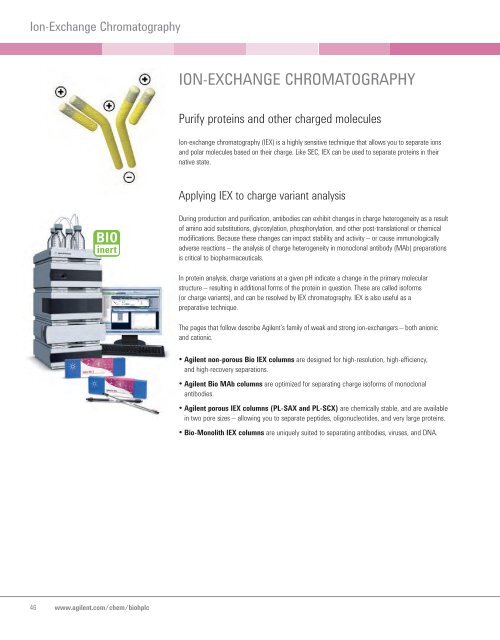BioHPLC Column Selection Guide Cover - Agilent Technologies
BioHPLC Column Selection Guide Cover - Agilent Technologies
BioHPLC Column Selection Guide Cover - Agilent Technologies
Create successful ePaper yourself
Turn your PDF publications into a flip-book with our unique Google optimized e-Paper software.
ion-exchange Chromatography<br />
4 www.agilent.com/chem/biohplc<br />
iOn-eXCHanGe CHROMaTOGRaPHY<br />
Purify proteins and other charged molecules<br />
Ion-exchange chromatography (IEX) is a highly sensitive technique that allows you to separate ions<br />
and polar molecules based on their charge. Like SEC, IEX can be used to separate proteins in their<br />
native state.<br />
Applying IEX to charge variant analysis<br />
During production and purification, antibodies can exhibit changes in charge heterogeneity as a result<br />
of amino acid substitutions, glycosylation, phosphorylation, and other post-translational or chemical<br />
modifications. Because these changes can impact stability and activity – or cause immunologically<br />
adverse reactions – the analysis of charge heterogeneity in monoclonal antibody (MAb) preparations<br />
is critical to biopharmaceuticals.<br />
In protein analysis, charge variations at a given pH indicate a change in the primary molecular<br />
structure – resulting in additional forms of the protein in question. These are called isoforms<br />
(or charge variants), and can be resolved by IEX chromatography. IEX is also useful as a<br />
preparative technique.<br />
The pages that follow describe <strong>Agilent</strong>’s family of weak and strong ion-exchangers – both anionic<br />
and cationic.<br />
• <strong>Agilent</strong> non-porous Bio IEX columns are designed for high-resolution, high-efficiency,<br />
and high-recovery separations.<br />
• <strong>Agilent</strong> Bio MAb columns are optimized for separating charge isoforms of monoclonal<br />
antibodies.<br />
• <strong>Agilent</strong> porous IEX columns (PL-SAX and PL-SCX) are chemically stable, and are available<br />
in two pore sizes – allowing you to separate peptides, oligonucleotides, and very large proteins.<br />
• Bio-Monolith IEX columns are uniquely suited to separating antibodies, viruses, and DNA.

















